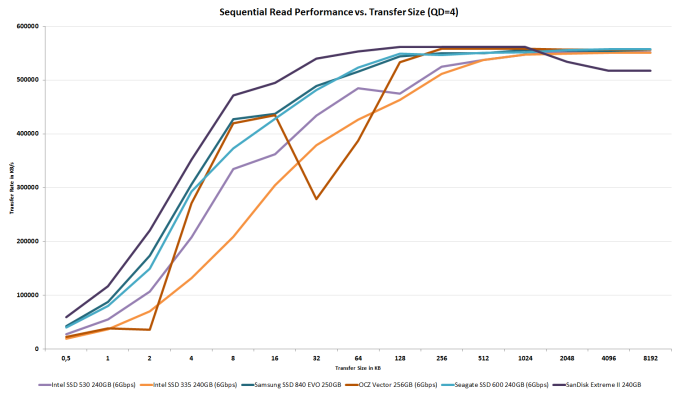Intel SSD 530 (240GB) Review
by Kristian Vättö on November 15, 2013 1:45 PM EST- Posted in
- Storage
- SSDs
- Intel
- Intel SSD 530
Performance vs. Transfer Size
ATTO is a useful tool for quickly benchmarking performance across various transfer sizes. You can get the complete data set in Bench. SandForce's read performance has never been top notch and the SSD 530 is no exception. Compared to the SSD 335, read speeds are better across all smaller IO sizes but as you can see the SSD 530 is beaten by most of today's SSDs. The story is similar with write performance, although differences are noticeably smaller. The SF-2281 is really starting to show its age because it used to dominate all ATTO benchmarks thanks to the use of highly compressible data but those times seem to be over.
Click for full size












60 Comments
View All Comments
HisDivineOrder - Saturday, November 16, 2013 - link
Remember when Sandforce used to be desired? That was a long, long time ago. Now they stink of bad firmwares and ugly compromise.jwcalla - Saturday, November 16, 2013 - link
I'm surprised we haven't seen a new gen from them yet. I wonder if they're even working on anything.purerice - Sunday, November 17, 2013 - link
True. It is a better problem to have than great firmware with bad hardware though. I mean, if they have the desire, they can fix existing drives. If they don't, they'll just lose customers, end of story.GuizmoPhil - Sunday, November 17, 2013 - link
The mITX ASUS Maximus VI Impact also got an M2 slot.g00ey - Sunday, November 17, 2013 - link
Sorry but just I don't believe in PCIe as a viable interface for SSD storage. If SATA 6 Gbps turns out to be a bottleneck then make drives that use two SATA channels or more. Or even switch to SAS 12Gbbs which was introduced back in 2011. Not many changes will be needed when switching to SAS since SAS is pin-compatible with SATA and a SAS controller can run SATA drives. The only noticeable difference is that SAS is more stable and cable lengths up to 10 meters (33 feet) are possible whereas only 1 meter (3.3 feet) works for SATA. I also like the SFF-8087/8088 connectors which house 4 SAS/SATA channels in one connector, there is both an internal version (SFF-8087) and an external version (SFF-8088) of this connector, just like SATA vs eSATA.The major advantages of SAS/SATA over PCIe is spelled RAID and hot-swap so it only makes sense to implement PCIe based storage in ultra-portable applications and applications with extremely high demands on low-latency.
tygrus - Sunday, November 17, 2013 - link
How do the SSD's perform with a simultaneous mix of Read/Write ? eg. 70/30 mix of random R/W with Q=32 or simulate tasks that stream read-modify-write.emvonline - Sunday, November 17, 2013 - link
Couple items: The real difference with the 530 is low power options from Sandforce controller and potentially lower cost 20nm NAND. If it isnt cheaper than 520, don't buy it.Intel chose 2281 controller for its consumers SSDs over its internal controller. Why would you recommend that Intel do a consumer SSD with its internal controller? Intels 3500 internal controller is purchased from and fab'd by another company anyway. Do you think the performance it much better than Sandforce 2281 B2?
'nar - Monday, November 18, 2013 - link
I must be dense, because I still don't get why you criticize Sandforce so much about incompressible data. I don't see a need to put incompressible data on an SSD in the first place, so the argument is meaningless.For cost per GB of storage, most people still do not want SSD's holding 500GB of data. Why do they have over 500GB? Pictures, music, movies, ie incompressible data. Therefore, that is stored on a much more cost-effective hard drive and hence, irrelevant here.
I don't see a performance advantage either. What do you do with music and movies? Play them. How much speed does that require? 12MBps? Hard drives are fine for media servers. Maybe you want to copy to a flash drive, but it will be limited itself to about 150MBps for good USB 3 drives anyway. And if you are editing video often then you are likely going over that 20GB per day of writes, so you should put that on an enterprise scratch disk anyway.
So, you ask if Sandforce will "fix" this problem? What problem? It is the fundamental design feature they have. It is what makes them unique, and in "normal" system it is quite useful, reviewers looking for bigger sledge hammers not withstanding. That's like saying the president is not so bad, but maybe if he weren't so black.
You can break anything. These are not build to be indestructible, nobody would be able to afford them if they were. These are built for common use, and I do not see hammering incompressible data in these benchmarks a common use.
Kristian Vättö - Tuesday, November 19, 2013 - link
If you're using software based encryption, it's quite a big deal because all your data will be incompressible. For other SSDs it's the one and same whether the data is compressible or not, but for SandForce based SSDs it's not, so it's a thing worth mentioning. What would be the point of reviews in the first place if we couldn't point out differences and potential design flaws?'nar - Thursday, November 21, 2013 - link
noted. That's it. Not half of all benchmarks. I don't use software encryption for most of my data.